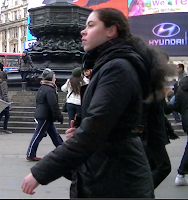Our Script:
 (4) Our target audience were mainly females aged 15-25. Their social class would be C1 as they are more likely to be youthful and enjoy that sort of Genre. Females are also more likely to find musicals interesting especially because they can relate to the protagonist more. Usually, students (High school or Post Graduate) who enjoy music and enjoy comedy films. The narrative is easy to follow as musicals mostly focus on the visuals and the music rather then the dialogue.
(4) Our target audience were mainly females aged 15-25. Their social class would be C1 as they are more likely to be youthful and enjoy that sort of Genre. Females are also more likely to find musicals interesting especially because they can relate to the protagonist more. Usually, students (High school or Post Graduate) who enjoy music and enjoy comedy films. The narrative is easy to follow as musicals mostly focus on the visuals and the music rather then the dialogue.(5) Our production card appealed to our musical enthusiasts as it presents the genre of the film. We chose a purple background which conveys feelings of happiness and joy, it also looks quite feminine. The title ‘musical note’ also shows the genre of the film which is about to begin.
The music we chose for our film was upbeat and would appeal to the audience as it is very common in musicals. It can appeal to the female audience as it is a young female singer so the audience would be able to connect with them . The lyrics ‘The best is yet to come’ also help to foreshadow future events in the film. In the opening shot, we decided to introduce the location. Piccadilly Circus is a very familiar public area which is often seen in musicals, as they are usually set in big cities. The protagonist is introduced as she is leaving the Underground Station so it is clear that she has travelled to this location. The illuminated advertising hoardings also give the location an appealing and harmonious look. The font that we used for the title ‘Big City’ looks very fresh and will most likely appeal to the younger females between the ages of 15-17. The hat that Agata is wearing is common among retro teenagers which were part of our target audience, this would be something that they may be able to relate to. The quick transitions pick up the pace of the film, this makes the film visually appealing to the younger audience and keeps them engaged especially as musicals are often fast paced. When filming, the weather was sunny. This was beneficial as it reflected the characters happy feelings. The cold weather also gave us reason for Agata wearing a coat as we did not want to show her entire costume straight away.
The use of the low angle shot makes the protagonist look powerful and strong as she steps into the centre of Piccadilly, this may appeal to the young female audience as they would be able to connect with the character in terms of age and can earn the viewers admiration. From research we saw that low angle shots were often used by males such as in the hairspray to make them look powerful on stage. The Over-the-shoulder shot that I used helps the audience understand that the character is going to a theatre and the leaflet indicates which theatre production it is. We relied on props such as those to introduce the narrative without the use of dialogue. The introduction of Hannah, as she bumps into Agata may also appeal to the audience as it encourages the female audience to have sympathy for the character. It also shows the audience how fragile the protagonist really is in such a big city.
The foyer as after she enters the building may appeal to the older audience as it looks prestigious and visually appealing, it helps the audience to understand that where the protagonist is going is extravagant. The mise-en-scene might also interest the audience in terms of lightning and costume. As Agata takes of her coat we are shown a much brighter and visually enticing costume. Our ‘lay’ audience would find the bright glowing colours appealing, it also gave Agata a joyful persona. Agata’s costume was influenced from the character Rachel from Glee as they both look young and dress colourfully. The lighting may appeal to the audience as it builds tension and shows the audience that a musical number is about to take place. The use of the high angle shot may encourage the female audience to sympathise for the character as she looks timid and ambivalent. The lighting also helps to show that the character is completely alone and independent. From research we learnt that high angle shots are often used on stage as they can clearly show the characters body language in the shot and their movement on stage.
The final shot, a close-up on Agata’s face help to show the audience her expression, this helps the audience connect with the character as they can clearly see what she is feeling. We cut off just before a musical number is about to start.


































